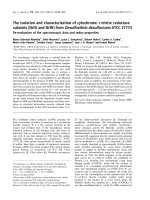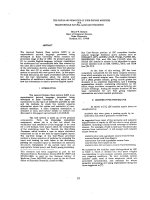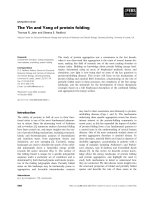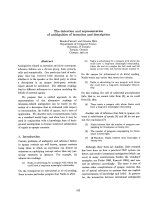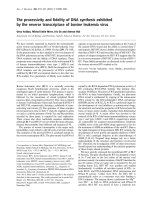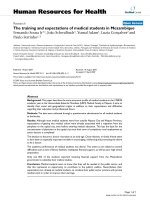báo cáo sinh học:" The training and expectations of medical students in Mozambique" doc
Bạn đang xem bản rút gọn của tài liệu. Xem và tải ngay bản đầy đủ của tài liệu tại đây (244.65 KB, 7 trang )
BioMed Central
Page 1 of 7
(page number not for citation purposes)
Human Resources for Health
Open Access
Research
The training and expectations of medical students in Mozambique
Fernando Sousa Jr*
1
, João Schwalbach
1
, Yussuf Adam
1
, Luzia Gonçalves
2
and
Paulo Ferrinho
1,3
Address:
1
Associação para o Desenvolvimento e Cooperação Garcia de Orta (AGO), Lisbon, Portugal,
2
Unidade de Epidemiologia e Bioestatistica,
Instituto de Higiene e Medicina Tropical, Universidade Nova de Lisboa, Lisbon, Portugal and
3
Unidade de Sistemas de Saúde e Centro de Malária
e Outras Doenças Tropicais, Instituto de Higiene e Medicina Tropical, Universidade Nova de Lisboa, Lisbon, Portugal
Email: Fernando Sousa* - ; João Schwalbach - ;
Yussuf Adam - ; Luzia Gonçalves - ; Paulo Ferrinho -
* Corresponding author
Abstract
Background: This paper describes the socio-economic profile of medical students in the 1998/99
academic year at the Universidade Eduardo Mondlane (UEM) Medical Faculty in Maputo. It aims to
identify their social and geographical origins in addition to their expectations and difficulties
regarding their education and professional future.
Methods: The data were collected through a questionnaire administered to all medical students
at the faculty.
Results: Although most medical students were from outside Maputo City and Maputo Province,
expectations of getting into medical school were already associated with a migration from the
periphery to the capital city, even before entering medical education. This lays the basis for the
concentration of physicians in the capital city once their term of compulsory rural employment as
junior doctors is completed.
The decision to become a doctor was taken at an early age. Close relatives, or family friends seem
to have been an especially important variable in encouraging, reinforcing and promoting the desire
to be a doctor.
The academic performance of medical students was dismal. This seems to be related to several
difficulties such as lack of library facilities, inadequate financial support, as well as poor high school
preparation.
Only one fifth of the students reported receiving financial support from the Mozambican
government to subsidize their medical studies.
Conclusion: Medical students seem to know that they will be needed in the public sector, and
that this represents an opportunity to contribute to the public's welfare. Nevertheless, their
expectations are, already as medical students, to combine their public sector practice with private
medical work in order to improve their earnings.
Published: 19 April 2007
Human Resources for Health 2007, 5:11 doi:10.1186/1478-4491-5-11
Received: 19 August 2004
Accepted: 19 April 2007
This article is available from: />© 2007 Sousa et al; licensee BioMed Central Ltd.
This is an Open Access article distributed under the terms of the Creative Commons Attribution License ( />),
which permits unrestricted use, distribution, and reproduction in any medium, provided the original work is properly cited.
Human Resources for Health 2007, 5:11 />Page 2 of 7
(page number not for citation purposes)
Background
Mozambique, previously a Portuguese colony, became
independent in 1975 and had a single party political sys-
tem until 1994, when the first multi-party elections were
held.
Mozambique is classified as a low human development
country and the poverty index is the highest in the South-
ern African Development Community (SADC) region
[1,2].
Since the peace agreement signed by Resistência Nacional
Moçambicana (RENAMO) and Frente de Libertação de
Moçambique (FRELIMO) in 1992, Mozambique has
embarked on a major economic restructuring process,
changing from a centrally planned to a market economy
[3]. A new constitution was introduced in 1990, opening
the way for the peace process and for a multi-party elec-
tion in 1994. A plethora of new laws and regulations have
been issued since then, legalizing or liberalizing economic
activities including health services that previously were
under absolute state control [2].
Following the civil war, the health services have gone
through a period of rapid expansion but the access to
health care is still poor [4]. In 1999, of a total of 406 Med-
ical doctors holding clinical posts, there were 204 foreign-
ers. Of 298 specialist medical doctors, 173 were
concentrated in Maputo city (responsible for over 34% of
the national Gross Domestic Product [1]) where it is easier
to develop private medical practice. According to Vio,
many of the national doctors work part-time in the private
sector [5].
Currently, the Mozambican health system is a mixed
economy of public and private sector players. The public
healthcare sector actually involves eight Ministries, but it
is dominated by the services provided by the Ministry of
Health [4], the main provider of health care services in the
country which remains highly dependent upon external
financial support [5].
In Mozambique medical students are trained in two facul-
ties, the Maputo based, public sector Medical Faculty of
the University Eduardo Mondlane and the private sector
Faculty of Medicine in Beira, integrated into the Catholic
University. There is talk of a third Faculty in Nampula. The
Beira Faculty of Medicine is a recently established institu-
tion, functioning since 2001.
The principal provider of undergraduate medical training
has been the Faculty of Medicine in Maputo. Its output
has been erratic (see Figure 1). Medical education has
tried to keep up with the changes in the health care sys-
tem. Established in 1963 in the colonial period, it has,
since independence, trained doctors to meet to some
extent the needs of a then exclusively public sector social-
ist health care system, partially free at the point of deliv-
ery. More recently, the Medical School has tried to adapt
its medical syllabus to accommodate a more nuanced and
realistic vision of a Mozambican society with a multitude
and diversity of health care sectors [2].
The training curriculum introduced after independence
remained unchanged up to 1982. In 1985, the teaching of
several ideological subjects (Marxism-Leninism, and
Political Economy) was dropped. The course duration was
increased from six to seven years. New subjects were intro-
Number of graduates of the Maputo Medical School- UEMFigure 1
Number of graduates of the Maputo Medical School- UEM. Source: Medical Faculty of Maputo
0
5
10
15
20
25
30
35
40
45
50
1965 1970 1975 1980 1985 1990 1995 2000
Years
Number of graduates
Human Resources for Health 2007, 5:11 />Page 3 of 7
(page number not for citation purposes)
duced such as Informatics, English and Physical Educa-
tion. These three subjects were subsequently dropped
during a period of curriculum reform in 1995/96. A new
curriculum planned in the "2003–2005 Strategic Plan of
the Faculty" is currently being implemented [2].
Concerning the selection of medical students, there are –
in several countries including some in Africa – pro-
grammes based on affirmative action aiming to increase
the intake of medical students from disadvantaged socio-
economic, ethnic, or geographic factions [6]. The purpose
of these programmes is to redress inequities from the past,
avoiding in particular geographical imbalances [7], espe-
cially in rural or poor areas. Such imbalances result in a
situation that has serious adverse consequences for health
system performance [8]. On the other hand, the pro-
grammes are designed to select applicants who have gen-
uine merit, in order to produce physicians that reflect
more "closely the social groups for which they are going
to care" [7]. Nevertheless, most health training institu-
tions, including the Faculty of Medicine in Maputo, still
use academic record as the primary selector criteria for
medical school entrance.
This paper describes the socio-economic profile of medi-
cal students in the 1998/99 academic year at the Universi-
dade Eduardo Mondlane (UEM) Medical Faculty in
Maputo, with the aim of identifying their social and geo-
graphical origins and their expectations and difficulties
regarding their education and professional future.
Methods
A piloted, standardized questionnaire, with both definite
and open-ended questions, was distributed to all regis-
tered medical students (from 1 st to 7 th year of medical
education) on a specified day, during agreed lecture peri-
ods, in April and May of 1999 (see Figure 2).
All data were entered into an Access database and ana-
lysed using SPSS. The statistical analysis is mostly descrip-
tive.
Two hundred and twenty-seven (51%) of the 441 students
registered completed and returned the questionnaire (see
Figure 3). Their ages ranged from 18 to 36 years (median
and mean of 23 years). Sixty-one percent of the respond-
ents were women and 10% were married (86% of those
being women).
Results
This section reports on the students' backgrounds, on the
decision to study medicine, on their academic perform-
ance and on difficulties and expectations.
Distribution of all medical students by academic year, 1998/99Figure 2
Distribution of all medical students by academic year, 1998/99.
1st
2nd
3rd
4th
5th
6th
7th
Human Resources for Health 2007, 5:11 />Page 4 of 7
(page number not for citation purposes)
Students' backgrounds
Most (56%) students were born and received their pri-
mary school education outside Maputo Province and
Maputo City, where the medical school is located. Sixty-
three percent of the students enrolled in the medical
school had finished their high school education in
Maputo, although the region only contains 6% of the
country's population. Forty-three percent lived with their
parents; 24% with other relatives; 23% in hostels and the
remainder indicated other living arrangements.
The decision to study medicine
Twenty percent took their decision to study medicine
when they were aged between 15 to 16 years, although the
range reported varied from ages 4 to 30 years. By the age
of 18 years, 65% had already decided to undertake a med-
ical course.
Table 1 shows that 90% reported that their parents had in
some way been associated with the health sector: as doc-
tors (29%), nurses (29%), health sector personnel (18%),
pharmacists (8%), auxiliaries (2%) or in some other cate-
gory (5%). Forty-six percent reported having uncles and/
or aunts that were associated with the health profession,
with 24% having friends working in the discipline and
30% noting other reference people similarly involved.
The main reasons for choosing medicine as a profession
were "to contribute towards the welfare of the public"
(60%), "self-realization" (48%), "vocation" (34%) and
Returned questionnaires from the medical studentsFigure 3
Returned questionnaires from the medical students.
Medical students versus returned
questionnaires
0
20
40
60
80
100
120
140
160
180
1st 2nd 3rd 4th 5th 6th 7th n/a
Academic year
Students enrolled Returned questionnaires
Human Resources for Health 2007, 5:11 />Page 5 of 7
(page number not for citation purposes)
"social recognition" (13%). "Family tradition" was actu-
ally acknowledged as a reason only by 2% of the students.
Academic performance
Five (6%) of the 79 first-year students were repeating the
year for the second or third time. Only 46 (32%) of the
143 students enrolled in the subsequent years had not
failed any academic year (see Table 2).
Financial support
Sixty-nine percent of the students were self-financing their
medical education; 19% received a scholarship from the
government, 6% from an international NGO and the
remainder financed their studies by other means.
Main difficulties reported
The most frequent difficulties reported by the students
during the medical training were: "lack of available refer-
ence books" (66%) and "financial" (58%). Other difficul-
ties were "lack of adequate technology" (22%), "teachers
not adequately prepared" (22%), "inadequate syllabus"
(8%) and "inadequate preparedness by the high school
education system" (8%).
Satisfaction with the academic education received
Fifty-four percent of the students were satisfied or partially
satisfied with the burden of lecturing and learning hours
demanded by the medical school. Twenty-six percent were
unhappy or partially unhappy with it and 20% did not
have any opinion.
Regarding the quality of the training received, 52% felt it
was adequate or very adequate, 20% that it was inade-
quate or very inadequate and the remainder did not have
any opinion.
Expectations regarding their future professional income
When asked about their intentions regarding the sectors
within which they would like to practice medicine after
completing their medical education (more than one
choice possible), 82% reported the public sector, 40% the
private for profit sector and 21% the private not for profit
sector.
Of 186 students who preferred the public sector, 36%
indicated the intention of combining a public sector job
with work in the private for-profit sector, and 17%
Table 2: Academic performance
Year of medical degree
Repeating current year of registration for n
th
time 1
st
2
nd
3
rd
4
th
5
th
6
th
7
th
Total
0 741996372 120
1 48136596 51
2 1276441 25
3 15253 16
4 14 12 8
5 1 1
6 1 1
Total 793238211825 9 222
Table 1: Students' family, friends, and others associated with the health sector
Parents % Friends % Uncles/Aunts % Other %
Pharmacists 18 8 6 3 13 6 4 2
Doctors 65 29 21 9 32 14 19 8
Nurses 65 29 13 6 30 13 21 9
Health sector personnel 40 18 11 5 20 9 12 5
Auxiliaries 5 2 2 1 3 1 4 2
Other categories 12 5 2 1 6 3 7 3
No answer 22 10 172 76 123 54 160 70
Total 227 100 227 100 227 100 227 100
Human Resources for Health 2007, 5:11 />Page 6 of 7
(page number not for citation purposes)
declared the intention of coupling public sector activities
with activities in the private not-for-profit sector.
Concerning what they would consider a fair level of
monthly income after graduation, the results were: less
than US$ 714 for 14%, US$ 715 -1071 for 36%, US$
1072–1428 for 17%, and 1429 US$ or over for 33% (see
Figure 4).
Discussion
As expected, the medical students questioned were not
representative of the diversity of the Mozambican popula-
tion [9]. Although most were from outside Maputo City
and Maputo Province, expectations of being accepted into
medical school were already associated with a migration
from the periphery to the capital city, even before entering
medical education. This forms the basis for the concentra-
tion of physicians in the capital city once their term of
compulsory rural employment as junior doctors is com-
pleted [10].
It is known that an individual's social background, age,
gender, individual expectations and career advancement
plans influence that person's decisions concerning the
geographical location of their medical practice. For exam-
ple, growing up in rural communities increases the prob-
ability of practising in rural areas [6]; female medical
doctors are less prone to accept rural posts; and younger
individuals with smaller families are more prepared to
migrate [8]. The medical faculty's selection criteria do not
take such trends into account, although they could help to
reduce the concentration of physicians in the capital city.
The decision to become a doctor is taken at an early age.
Although this decision seems to be in order to fulfil the
students' wishes of contributing to public sector values, it
is undeniable that having family and/or friends already in
the health professions is likely to have an enormous influ-
ence on them. Close relatives or family friends are an
especially important variable in encouraging, reinforcing
and promoting the desire to be a doctor [9].
The level of academic performance is dismal. This seems
to be related to several difficulties such as lack of library
facilities, inadequate financial support, as well as poor
high school preparation. It is not surprising that poor per-
formance should be associated with a high degree of dis-
satisfaction with the quality of teaching and burden of
lecturing. These difficulties have been previously
described [11].
Only one fifth of the students reported receiving financial
support from the Mozambican government, a figure that
compares unfavourably with the 45% reported for the stu-
dents who had completed their studies in the previous 5
years [10]. The extent to which this interferes with the
ability of students to complete their medical studies or
forces them to start the practice of medicine prematurely
was not clear.
Conclusion
Medical students seem to know that they will be needed
in the public sector, and that this represents an opportu-
nity to contribute to the public's welfare. Nevertheless,
their expectations are, in order to improve their earnings,
to combine their public sector practice with private medi-
cal work [12,13]. Their income expectations were: for one
third of respondents, from US$ 715 to US$ 1071, and for
another third, over US$ 1429. These expectations are put
into context when one notes that the salary of a newly
Expectations of future monthly incomeFigure 4
Expectations of future monthly income.
0 5 10 15 20 25 30 35 40
1
over US$ 1429
US$ 1072 - US$ 1428
US$ 715 - US$ 1071
US$ 358 - US$ 714
less than US$ 357
Publish with Bio Med Central and every
scientist can read your work free of charge
"BioMed Central will be the most significant development for
disseminating the results of biomedical researc h in our lifetime."
Sir Paul Nurse, Cancer Research UK
Your research papers will be:
available free of charge to the entire biomedical community
peer reviewed and published immediately upon acceptance
cited in PubMed and archived on PubMed Central
yours — you keep the copyright
Submit your manuscript here:
/>BioMedcentral
Human Resources for Health 2007, 5:11 />Page 7 of 7
(page number not for citation purposes)
graduated doctor at the time was about US$ 357a month
[14]. Thus, the scene is set for the reality of coping strate-
gies and dual practice that are often unregulated and that
plague many countries, including Mozambique [15].
Competing interests
The author(s) declare that they have no competing inter-
ests.
Acknowledgements
The present study received financial support from the Centro de Malária e
de Outras Doenças Tropicais – Instituto de Higiene e Medicina Tropical of
the Universidade Nova de Lisboa. The authors wish to express their grati-
tude to the medical students of the Maputo Medical School.
References
1. UNDP: Economic growth and human development:
Progress, obstacles and challenges. In Mozambique National
Human Development Report Maputo; 1999.
2. Ferrinho P, Omar C: The Human Resources for Health Situa-
tion in Mozambique. In African Region Human Development Working
Paper Series n° 91 Washington, The World Bank; 2006.
3. Schwalbach J, Abdula M, Adam Y, Khan Z: Good Samaritan or
exploiter of illness? Coping strategies of Mozambican health
care providers. Providing health care under adverse conditions: Health
personnel performance & individual coping strategies 2000, 16:121-134.
4. Yates R, Zorzi N: Health Expenditure Review Mozambique. Technical
Assistance Provided by Planning Management Development Project Man-
agement Sciences for Health. Funding provided by The US Agency for Inter-
national Development (USAID) Under Cooperative Agreement CCP-3055-
A-00-5000-00; 1999.
5. Vio F: Management of expatriate medical assistance in
Mozambique. Human Resources for Health 2006, 4:26.
6. Vries E, Reid S: Do South African rural origin medical students
return to rural practice? School of Public Health and Family Med-
icine, University of Cape Town; 2003.
7. Tutton Peter, Price Max: Selection of medical students. British
Medical Journal 2002, 324:1170-1171.
8. Dussault G, Franceschini MC: Not enough here, too many there:
understanding geographical imbalances in the distribution of
health personnel. Human Resources for Health 2006, 4:12.
9. Backström B, Ferrinho P: Socialisation of Medical Students. In
Unpublished Document IHMT/UNL, CMDT, Lisboa; 1998.
10. Sousa F Jr: Contributos para o Estudo da Formação de Médi-
cos em Moçambique no Pós-Independência: Estudo de Caso.
In Master Dissertation ISEG – UTL, Lisbon; 2001.
11. Mccord C, Costa JL, Schiapa M: Relatório de Consultoria sobre a
Formação de Médicos Especialistas Moçambicanos no
período 1999–2010. In Unpublished Report Ministry of Health,
Maputo; 1998.
12. Ferrinho P, Van Lerberghe W, Gomes AC: Coping with reform of
the Health Personnel System in Africa. IHMT/UNL, CMDT,
Lisboa; 1998.
13. Ferrinho P, Van Lerberghe W, Editors: Providing health care
under adverse conditions: Health personnel performance &
individual coping strategies. In Health Services Organisation & Pol-
icy, Studies in Health Services Organizations and Policy, 16 Antwerp, ITG
Press; 2000.
14. Ferrinho P, Van Lerberghe W, Julien MR, Fresta E, Gomes A, Dias F,
Gonçalves A, Backström B: How and Why public sector doctors
engage in private practice in Portuguese-speaking African
countries. In Health Policy and Planning Volume 13. Issue 3 Oxford,
Oxford University Press; 1998:332-338.
15. Lerberghe W, Conceição C, Van Damme W, Ferrinho P: When
Staff is underpaid: Dealing with the individual coping strate-
gies of health personnel. Bulletin of the World Health Organization
2002, 80(7):581-584.
